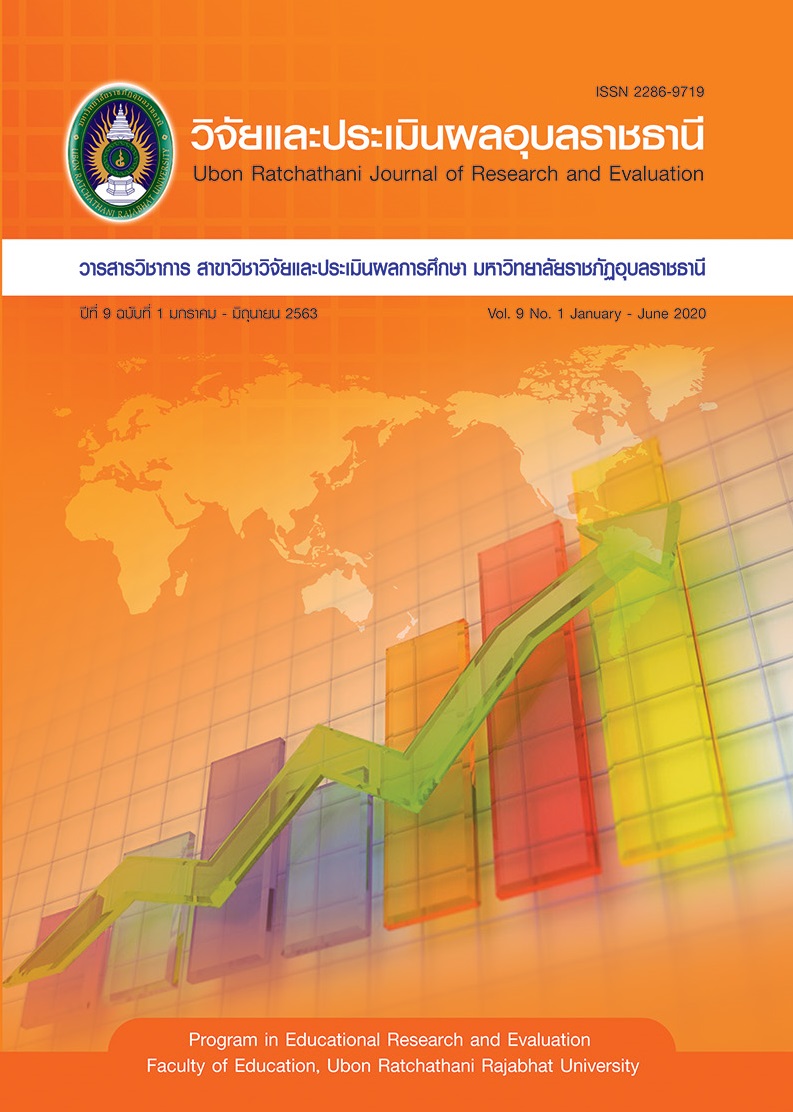The Causal Model Affecting Information Literacy
Keywords:
information literacy, external, internal, structural equation model: SEMAbstract
The purpose of this research was to validate of a causal model which affect information literacy of undergraduates of Roi Et Rajabhat University. The samples were 400 undergraduates of Roi Et Rajabhat University who had enrolled in Individual Studies and Information Technology for Work in the academic year of 2019, which was selected by simple random sampling. The variables consisted of one exogenous latent variable: external factor; and two endogenous latent variables: internal Factor and information literacy. The research tools were 3 questionnaires. Jamovi program and R program with package lavaan were used to analyze the data.
The research findings were as follows; the causal model of information literacy of undergraduates of Roi Et Rajabhat University showed model fit to empirical data (chi-square=53.014, p-value=0.099, df=41, chi-square/df=1.293, CFI=0.998, TLI=0.995, RMSEA=0.027, SRMR=0.016, GFI=0.983, AGFI=0.951). Moreover, the variables in model could explain the variance of information literacy at 68.80 percent. When considering direct effect, it found that external factor and internal factor affected on information literacy and external factor affected to internal factor which was significantly at the level of .01. In addition, when considering indirect effect, it found that external factor affected on information literacy indirectly through internal factor which was statistically significance at .01.
References
กนกภรณ์ เทสินทโชต. (2560). ปัจจัยที่ส่งผลต่อผลสัมฤทธิ์ทางการเรียนของนักเรียนระดับชั้นประถมศึกษาปีที่ 6 ในโรงเรียน ขนาดเล็ก สังกัดสำนักงานเขตพื้นที่การศึกษาประถมศึกษาสระแก้ว เขต 1 (งานนิพนธ์หลักสูตรรัฐประศาสนศาสตรมหาบัณฑิต, กลุ่มวิชาการบริหารทั่วไป). มหาวิทยาลัยบูรพา, ชลบุรี.
Tesasinchote, K. (2017). Factors affecting learning achievement among pathom 6 students in small-sized schools under the office of basic educational area 1, Sa-kaeo province (Master of public administration thesis, program in General Administration). Burapha University, Chonburi. [in Thai].
ชยาภรณ์ คําตุ้ย. (2560). ปัจจัยเชิงสาเหตุที่ส่งผลต่อทักษะชีวิตและงานอาชีพในศตวรรษที่ 21 ของนักเรียนกลุ่มชาติพันธุ์ ชั้นประถมศึกษาปีที่ 6 สังกัดสำนักงานเขตพื้นที่การศึกษาประถมศึกษาเชียงราย เขต 3. วารสารการวิจัยกาสะลองคํา มหาวิทยาลัยราชภัฏเชียงราย, 11(2), 25-33.
Kumtui, C. (2017). Causal factor influencing in life and career skills in 21st century of Prathom Suksa 6 Hill-tribe Under the Chiang Rai Primary Educational Service Area office 3. Research Journal Kasalongkhum Chiang Rai Rajabhat University, 11(2), 25-33. [in Thai].
ราชกิจจานุเบกษา. (2562, 1 พฤษภาคม). พระราชบัญญัติการอุดมศึกษา พ.ศ. 2562. เล่ม 136 ตอนที่ 57 ก. หน้า 58.
Royal Thai Government Gazette. (2018, 1st May). Higher Education Act 2019. Vol. 136 Chapter 57g. p. 58. [in Thai].
รุจริพรรณ คงช่วย. (2559). รูปแบบความสัมพันธ์ เชิงสาเหตุของปัจจัยที่มีอิทธิพลต่อผลสัมฤทธิ์ทางการเรียนของ นักศึกษาคณะครุศาสตร์ มหาวิทยาลัยราชภัฏเขตภาคใต้ ครุศาสตร์ มหาวิทยาลัยราชภัฏสงขลา (รายงานวิจัย). สงขลา: มหาวิทยาลัยราชภัฏสงขลา.
Kongchuay, R. (2016). The causal relationship model of factors influencing achievement of students, faculty of Education, Rajabhat Universities in Southern Regional Area (Research report). Songkhla: Songkhla Rajabhat University. [in Thai].
วลัยลักษณ์ อมรสิริพงศ์. (2561). การรู้สารสนเทศของนักศึกษาปริญญาตรี มหาวิทยาลัยราชภัฏนครปฐม. วารสารสารสนเทศศาสตร์, 36(3), 41-66.
Amornsiriphong, W. (2018). Information literacy of Nakhon Pathom Rajabhat University Undergraduate Students. Journal of Information Scienc,. 36(3), 41-66. [in Thai].
สมประสงค์ เสนารัตน์, พิสิฐ พินิจสกุล และเบญจมาภรณ์ เสนารัตน์. (2563). The Validation of Casual Model of Teacher Spiritual. วารสารศึกษาศาสตร์, 31(2).
Senarat, S., Pinitsakul, P., and Senara, B. (2020). The Validation of Casual Model of Teacher Spiritual. Journal of Education, 31(2). [in Thai].
สิริพงษ์ ครบอุดม และแกมกาญจน์ สมประเสริฐศรี. (2561). การพัฒนาทักษะการรู้สารสนเทศของนิสิต คณะพยาบาลศาสตร์ มหาวิทยาลัยมหาสารคาม. วารสารสารสนเทศศาสตร์, 36(3), 128-145.
Krobudom, S. and Somprasertsri, G. (2018). The Development of Information Literacy Skill of Nursing Students of the Faculty of Nursuing, Mahasarakram University. Journal of Information Science, 36(3), 128-145. [in Thai].
Association of College and Research Libraries. (2016). Framework for information literacy for higher education. Retrieved June 20, 2020, from http://www.ala.org/acrl/standards/ilframework
Brown, T. A. (2006). Confirmatory factor analysis for applied research. New York: The Guilford Press.
Bruce ,C. (2016). Information literacy research: Dimensions of the emerging collective consciousness. Journal of the Australian Academic and Research Libraries, 47(4), 220-238.
Dunn, K. (2000). Assessing information literacy skills in the California State University: A progress report. The Journal of Academic Librarianship, 28(1), 26-35.
Hair, Joseph F., Jr., Black, William C., Babin, Barry J., and Anderson, Rolph E. (2014). Multivariate data analysis (7th ed.). Upper Saddle River, NJ: Prentice Hall.
Jones, A. I., Gardner, C., Zaenglein, J. I. (1998). Desperately seeking standards. Knowledge Quest, 26(3), 38-42.
Julien, H. and Boon, S. (2004). Assessing instructional outcomes in Canadians academic libraries. Library and Information Science Research, 26(2), 121-139.
Materska, K. (2013). Is Information Literacy Enough for a Knowledge Worker?, In European Conference on Information Literacy. (pp. 229-235). Turkey: Istanbul.
Prescott, B. A. (1961). Report of Conference on Child Student. Education Bulletin. Bangkok: Faculty of Education, Chulalongkorn University.
Rosseel, Y. (2012). lavaan: An R package for structural equation modeling. Journal of Statistical Software, 48(2), 1-36.
The Jamovi Project. (2019). Jamovi (Version 1.0) [Computer Software]. Retrieved May 20, 2020, from https://www.jamovi.org.
Downloads
Published
How to Cite
Issue
Section
License
1. บทความที่ตีพิมพ์ในวารสารนี้ได้มีการตรวจสอบการลอกเลียนงานวรรณกรรมแล้ว ไม่เกินร้อยละ 25
2. บทความที่ตีพิมพ์ในวารสารนี้เป็นข้อคิดเห็น ข้อค้นพบของผู้เขียนบทความ โดยผู้เขียนบทความต้องเป็นผู้รับผิดชอบต่อผลทางกฎหมายใด ๆ ที่อาจเกิดขึ้นจากบทความนั้น ๆ
3. บทความ ข้อมูล เนื้อหา รูปภาพ ฯลฯ ที่ได้รับการตีพิมพ์ในวารสารวิจัยและประเมินผลอุบลราชธานี ถือเป็นลิขสิทธิ์ของวารสารวิจัยและประเมินผลอุบลราชธานี หากบุคคลหรือหน่วยงานใดต้องการนำทั้งหมดไปเผยแพร่ต่อหรือเพื่อกระทำการใดๆ จะต้องได้รับอนุญาตเป็นลายลักษณ์อักษรจากวารสารวิจัยและประเมินผลอุบลราชธานีก่อนเท่านั้น และจะต้องมีการอ้างอิงวารสารวิจัยและประเมินผลอุบลราชธานี ฉบับนั้น ๆ ด้วย






